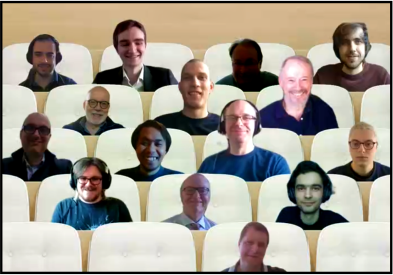The seventh annual meeting of the Oxford Centre for High Energy Density Science (OxCHEDS) took place online on the 22nd and 23rd of March, and attracted a record 52 registrants from AWE and the University of Oxford.
The previous year’s meeting, which was originally scheduled to take place at Lady Margaret Hall in March of 2020, coincided almost exactly (and rather unfortunately) with the onset of the UK’s first national lockdown, and thus had to be cancelled at the last minute. Similar restrictions threatened to prevent a meeting taking place once again this year; however, the interactions and collaborative opportunities offered by the OxCHEDS Annual Meeting were felt to be too important to be deferred for a second time, and so the decision was made to move to a virtual format. Despite its reduced timetable, the meeting proved to be a success.

brought together using the magic of Microsoft Teams.
Justin Wark, Director of OxCHEDS, opened the meeting with a brief talk summarising the history of the collaboration between Oxford and AWE, and how this was cemented through the formal establishment of OxCHEDS in 2013. There then followed four technical sessions, spread over the course of two days, featuring a diverse programme of talks showcasing OxCHEDS’ broad research portfolio. Among the many talks delivered, there were several illustrating shared research interests and ongoing collaborative research efforts between the University of Oxford and AWE.
The two institution’s common interest in applying machine-learning techniques to solve problems in high energy density science was reflected in the talks of Muhammad Kasim (Oxford) and Colin Brown (AWE): Muhammad explained how his differentiable density functional theory could be brought to bear on the long-standing challenge of calculating the exchange-correlation functional, while Colin’s talk explored the feasibility of using particle-swarm optimisation to perform warm-dense-matter opacity measurements. The following session featured a series of interconnected talks concerning experimental and computational studies of texture evolution under dynamic compression conditions by Paddy Heighway (Oxford), Philip Avraam (AWE), and Emma Floyd (AWE), which was introduced and contextualised in a keynote talk delivered by Justin entitled ‘Diffraction and MD – A brief history’.
The two-day meeting was concluded by Colin Danson, AWE Distinguished Scientist and AWE Coordinator for OxCHEDS, who delivered a second keynote speech entitled `60th Anniversary of the Laser – A History of High Power Laser Development in the UK’, an abridged version of a recently accepted review paper detailing the role of UK academia, industry, and national laboratories in the evolution of the high-power laser technology now instrumental in much of the work performed by OxCHEDS.
In lieu of the traditional soirée at Trinity College that would usually round off the first day of the meeting, Oliver Karnbach put together and presented the inaugural OxCHEDS Quiz (of which Tom Campbell was declared winner), an event which we hope will become a firm fixture in the OxCHEDS calendar!
We all look forward to convening once again next year for a face-to-face meeting!

